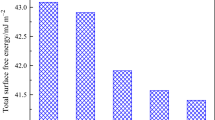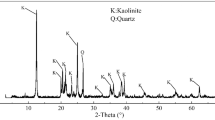Abstract
Metal cations have significant effects on the flotation of coal and minerals. In this study, the effects of monovalent cations (Na+ and K+) on the flotation of low-rank coal (LRC) were investigated using flotation and particle–bubble attachment experiments and through X-ray photoelectron spectroscopy (XPS) and molecular dynamics simulations. Oleic acid (OA), methyl linoleate (ML), hexadecyltrimethylammonium chloride (CTAC), ricinoleic acid (RA), and kerosene were used as flotation collectors. The flotation experiments revealed that the flotation yields of LRC improved when OA, ML, RA, CTAC, and kerosene were used in pure deionized water. However, flotation was suppressed for these collectors in the presence of K+ and Na+ ions. In contrast, when using CTAC, the flotation yield increased in the presence of these ions. Specifically, the flotation yield increased from 41.24 to 87.03% when 2.0 kg/t CTAC was used in 10 mmol/L NaCl solution. Particle–bubble adhesion experiments and XPS revealed that the hydrophilic groups of CTAC were adsorbed on the LRC surfaces by electrostatic forces, whereas the oxygen-containing functional groups of OA, ML, and RA formed hydrogen bonds with the LRC surface in pure water. Finally, the simulating result revealed that the hydrophobic ends of the OA, ML, and RA collectors hinder the flotation of LRC by adsorbing monovalent cations, whereas the adsorption of monovalent cations on the hydrophobic end of the cationic surfactant (CTAC) promotes flotation via strong electrostatic interactions.















Similar content being viewed by others
Data Availability
The data that support the findings of this study are available on request from the corresponding author upon reasonable request.
References
Osman H, Jangam S, Lease J et al (2011) Drying of low-rank coal (LRC)—a review of recent patents and innovations. Drying Technol 29:1763–1783. https://doi.org/10.1080/07373937.2011.616443
Lee SH, Lee TH, Jeong SM et al (2019) Economic analysis of a 600 mwe ultra supercritical circulating fluidized bed power plant based on coal tax and biomass co-combustion plans. Renew Energy 138:121–127. https://doi.org/10.1016/j.renene.2019.01.074
Wen B, Xia W, Sokolovic JM (2017) Recent advances in effective collectors for enhancing the flotation of low rank/oxidized coals. Powder Technol 319:1–11. https://doi.org/10.1016/j.powtec.2017.06.030
Xia W, Xie G, Peng Y (2015) Recent Advances in Beneficiation for Low Rank Coals. Powder Technol 277:206–221. https://doi.org/10.1016/j.powtec.2015.03.003
Zhen K, Zheng C, Li C et al (2018) Wettability and flotation modification of long flame coal with low-temperature pyrolysis. Fuel 227:135–140. https://doi.org/10.1016/j.fuel.2018.04.073
Hu H, Li M, Li L et al (2020) Improving bubble-particle attachment during the flotation of low rank coal by surface modification. Int J Min Sci Technol 30(2):217–223. https://doi.org/10.1016/j.ijmst.2019.04.001
Mao Y, Xia W, Peng Y et al (2019) Ultrasonic-assisted flotation of fine coal: a review. Fuel Process Technol 195:106150. https://doi.org/10.1016/j.fuproc.2019.106150
Tang L, Wang S, Guo J et al (2017) Exploration on the removal mechanism of sulfur ether model compounds for coal by microwave irradiation with peroxyacetic acid. Fuel Process Technol 159:442–447. https://doi.org/10.1016/j.fuproc.2016.12.019
Yoon R-H (1982) Flotation of coal using micro-bubbles and inorganic salts. Min Congress J 68:76–80
Yoon R, Sabey J (2022) Coal flotation in inorganic salt solutions. Mater Sci Forum:87–114. https://doi.org/10.1201/9780367813185-5
Li C, Somasundaran P (1993) Role of electrical double layer forces and hydrophobicity in coal flotation in sodium chloride solutions. Energy Fuel 7(2):244–248. https://doi.org/10.1021/ef00038a014
Liu J, Liang J, Feng X et al (2021) Effects of inorganic ions on the transfer of weak organic acids and their salts in electrodialysis process. J Membr Sci 624:119109. https://doi.org/10.1016/j.memsci.2021.119109
Chen Y, Chen X, Peng Y (2020) The effect of sodium hydrosulfide on molybdenite flotation in seawater and diluted seawater. Miner Eng 158:106589. https://doi.org/10.1016/j.mineng.2020.106589
Romero CP, Jeldres RI, Quezada GR et al (2018) Zeta potential and viscosity of colloidal silica suspensions: effect of seawater salts, pH, flocculant, and shear rate. Colloids Surf A Physicochem Eng Asp 538:210–218. https://doi.org/10.1016/j.colsurfa.2017.10.080
Quinn JJ, Kracht W, Gomez CO et al (2007) Comparing the effect of salts and frother (MIBC) on gas dispersion and froth properties. Miner Eng 20(14):1296–1302. https://doi.org/10.1016/j.mineng.2007.07.007
Klassen VI, Mokrousov VA (1963) An introduction to the theory of flotation. https://www.cs.cmu.edu/~cap/raid/daf/bib/klassen63a.html. Accessed 10 March 2023.
Laskowski J, Firth BA (2003) Coal flotation and fine coal utilisation. Int J Miner Process 70(1):251–252. https://doi.org/10.1016/S0301-7516(03)00004-8
Harvey PA, Nguyen AV, Evans GM (2002) Influence of electrical double-layer interaction on coal flotation. J Colloid Interface Sci 250(2):337–343. https://doi.org/10.1006/jcis.2002.8367
Ozdemir O, Taran E, Hampton MA et al (2009) Surface chemistry aspects of coal flotation in bore water. Int J Miner Process 92(3):177–183. https://doi.org/10.1016/j.minpro.2009.04.001
Peng Y, Zhao S, Bradshaw D (2012) Role of saline water in the selective flotation of fine particles. Water in Mineral Processing - Proceedings of the 1st International Symposium 15:61–71.
Zhang N, Chen X, Nicholson T et al (2019) The effect of saline water on the settling of coal slurry and coal froth. Powder Technol 344:161–168. https://doi.org/10.1016/j.powtec.2018.12.036
Castro S, Miranda C, Toledo P et al (2013) Effect of frothers on bubble coalescence and foaming in electrolyte solutions and seawater. Int J Miner Process 124:8–14. https://doi.org/10.1016/j.minpro.2013.07.002
Kurniawan AU, Ozdemir O, Nguyen AV et al (2011) Flotation of coal particles in MgCl2, NaCl, and NaClO3 solutions in the absence and presence of dowfroth 250. Int J Miner Process 98(3–4):137–144. https://doi.org/10.1016/j.minpro.2010.11.003
Paulson O, Pugh RJ (1996) Flotation of inherently hydrophobic particles in aqueous solutions of inorganic electrolytes. Langmuir 12(20):4808–4813. https://doi.org/10.1021/la960128n
Suyantara GPW, Hirajima T, Elmahdy AM et al (2016) Effect of kerosene emulsion in MgCl2 solution on the kinetics of bubble interactions with molybdenite and chalcopyrite. Colloids Surf A Physicochem Eng Asp 501:98–113. https://doi.org/10.1016/j.colsurfa.2016.04.039
An Y, Sun K, Qiu Y et al (2022) Specific cation effect on the flotation of graphite. Minerals 12(9):1070. https://doi.org/10.3390/min12091070
Marrucci G, Nicodemo L (1967) Coalescence of gas bubbles in aqueous solutions of inorganic electrolytes. Chem Eng Sci 22(9):1257–1265. https://doi.org/10.1016/0009-2509(67)80190-8
Lessard RR, Zieminski SA (1971) Bubble coalescence and gas transfer in aqueous electrolytic solutions. Ind Eng Chem Fund 10(2):260–269. https://doi.org/10.1021/i160038a012
Craig VSJ (2004) Bubble coalescence and specific-ion effects. Curr Opin Colloid Interface Sci 9(1):178–184. https://doi.org/10.1016/j.cocis.2004.06.002
Hofmeier U, Yaminsky VV, Christenson HK (1995) Observations of solute effects on bubble formation. J Colloid Interface Sci 174(1):199–210. https://doi.org/10.1006/jcis.1995.1383
Laskowski JS, Cho YS, Ding K (2003) Effect of frothers on bubble size and foam stability in potash ore flotation systems. Can J Chem Eng 81(1):63–69. https://doi.org/10.1002/cjce.5450810107
Craig VSJ, Ninham BW, Pashley RM (1993) Effect of electrolytes on bubble coalescence. Nature 364(6435):317–319. https://doi.org/10.1038/364317a0
Zhang Y, Zhu H, Zhu J et al (2022) Effect of inorganic cations on enhancing graphite/kerosene adsorption and reducing carbon emission in graphite flotation. Fuel 314:122740. https://doi.org/10.1016/j.fuel.2021.122740
Firouzi M, Nguyen AV (2014) Effects of monovalent anions and cations on drainage and lifetime of foam films at different interface approach speeds. Adv Powder Technol 25(4):1212–1219. https://doi.org/10.1016/j.apt.2014.06.004
Wei T, Peng Y, Vink S (2016) The joint action of saline water and flotation reagents in stabilizing froth in coal flotation. Int J Miner Process 148:15–22. https://doi.org/10.1016/j.minpro.2016.01.005
Wang B, Peng Y (2014) The effect of saline water on mineral flotation – a critical review. Miner Eng 66–68:13–24. https://doi.org/10.1016/j.mineng.2014.04.017
Bournival G, Zhang F, Ata S (2019) Coal flotation in saline water: effects of electrolytes on interfaces and industrial practice. Miner Process Extr Metall 42:1–21. https://doi.org/10.1080/08827508.2019.1654474
Jeldres RI, Forbes L, Cisternas LA (2016) Effect of seawater on sulfide ore flotation: a review. Miner Process Extr Metall 37(6):369–384. https://doi.org/10.1080/08827508.2016.1218871
James RO, Healy TW (1972) Adsorption of hydrolyzable metal ions at the oxide—water interface. I. Co(II) adsorption on SiO2 and TiO2 as model systems. J Colloid Interface Sci 40(1):42–52. https://doi.org/10.1016/0021-9797(72)90172-5
Crundwell FK (2016) On the mechanism of the flotation of oxides and silicates. Miner Eng 95:185–196. https://doi.org/10.1016/j.mineng.2016.06.017
Yuan M, Nie W, Zhou W et al (2020) Determining the effect of the non-ionic surfactant AEO9 on lignite adsorption and wetting via molecular dynamics (MD) simulation and experiment comparisons. Fuel 278:118339. https://doi.org/10.1016/j.fuel.2020.118339
Jin H, Zhang Y, Dong H et al (2022) Molecular dynamics simulations and experimental study of the effects of an ionic surfactant on the wettability of low-rank coal. Fuel 320:123951. https://doi.org/10.1016/j.fuel.2022.123951
Zhang L, Sun X, Li B et al (2020) Experimental and molecular dynamics simulation study on the enhancement of low rank coal flotation by mixed collector. Fuel 266:117046. https://doi.org/10.1016/j.fuel.2020.117046
Li Y, Xia W, Peng Y et al (2020) A novel coal tar-based collector for effective flotation cleaning of low rank coal. J Clean Prod 273:123172. https://doi.org/10.1016/j.jclepro.2020.123172
You X, He M, Zhang W et al (2018) Molecular dynamics simulations of nonylphenol ethoxylate on the Hatcher model of subbituminous coal surface. Powder Technol 332:323–330. https://doi.org/10.1016/j.powtec.2018.04.004
Li P (2019) The improvement of addition of inorganic salt on the wettability of coal dust by chemical dust suppressant. AEP 9(6):870–877. https://doi.org/10.12677/AEP.2019.96114
Zhen K, Zhang H (2018) Effect of NaCl on the flotation response of low-rank coal. Energy Sources Part A Recov Util Environ Effects 40(13):1613–1620. https://doi.org/10.1080/15567036.2018.1486482
Nguyen A, Schulze HJ (2004) Colloidal science of flotation, Boca Raton, Florida. https://doi.org/10.1201/9781482276411
Pietrzak R, Grzybek T, Wachowska H (2007) XPS study of pyrite-free coals subjected to different oxidizing agents. Fuel 86(16):2616–2624. https://doi.org/10.1016/j.fuel.2007.02.025
Xia W, Xie G (2014) Changes in the hydrophobicity of anthracite coals before and after high temperature heating process. Powder Technol 264:31–35. https://doi.org/10.1016/j.powtec.2014.05.016
Zhang R, Xing Y, Xia Y et al (2020) Synergistic adsorption mechanism of anionic and cationic surfactant mixtures on low-rank coal flotation. ACS Omega 5(32):20630–20637. https://doi.org/10.1021/acsomega.0c02948
Li B, Liu S, Fan M et al (2019) The effect of ethylene oxide groups in dodecyl ethoxyl ethers on low rank coal flotation: an experimental study and simulation. Powder Technol 344:684–692. https://doi.org/10.1016/j.powtec.2018.12.063
Harris GH, Diao J, Fuerstenau DW (1995) Coal flotation with nonionic surfactants. Coal Prep 16(3–4):135–147. https://doi.org/10.1080/07349349508905248
Dey S (2012) Enhancement in hydrophobicity of low rank coal by surfactants — a critical overview. Fuel Process Technol 94(1):151–158. https://doi.org/10.1016/j.fuproc.2011.10.021
Jia R, Harris GH, Fuerstenau DW (2000) An improved class of universal collectors for the flotation of oxidized and/or low-rank coal. Int J Miner Process 58(1):99–118. https://doi.org/10.1016/S0301-7516(99)00024-1
He MR, Zhang W, Cao X et al (2018) Adsorption behavior of surfactant on lignite surface: a comparative experimental and molecular dynamics simulation study. Int J Mol Sci 19:437. https://doi.org/10.3390/ijms19020437
Tao C, Feng H, Zhou J et al (2009) Molecular simulation of oxygen adsorption and diffusion in polypropylene. Acta Pnys Chim Sin 25:1373–1378. https://doi.org/10.3866/PKU.WHXB20090719
Núñez-Rojas E, Domínguez H (2011) Computational studies on the behavior of sodium dodecyl sulfate (SDS) at TiO2(rutile)/water interfaces. J Colloid Interface Sci 364(2):417–427. https://doi.org/10.1016/j.jcis.2011.08.069
Acknowledgements
The authors would like to thank Dr. Hu from Shiyanjia Lab (https://www.shiyanjia.com) for support of XPS and FTIR analysis and all the reviewers who participated in the review, as well as MJ Editor (https://www.mjeditor.com) for providing English editing services during the preparation of this manuscript.
Funding
This research was supported by the National Natural Science Foundation of China (No. 52264032).
Author information
Authors and Affiliations
Corresponding author
Ethics declarations
Conflict of Interest
The authors declare no competing interests.
Additional information
Publisher’s Note
Springer Nature remains neutral with regard to jurisdictional claims in published maps and institutional affiliations.
Rights and permissions
Springer Nature or its licensor (e.g. a society or other partner) holds exclusive rights to this article under a publishing agreement with the author(s) or other rightsholder(s); author self-archiving of the accepted manuscript version of this article is solely governed by the terms of such publishing agreement and applicable law.
About this article
Cite this article
Kong, R., Wang, S. & Gui, D. Effect of Sodium and Potassium Ions on the Flotation of Low-Rank Coal in the Presence of Different Collectors: A Theoretical and Experimental Study. Mining, Metallurgy & Exploration 41, 363–378 (2024). https://doi.org/10.1007/s42461-024-00927-1
Received:
Accepted:
Published:
Issue Date:
DOI: https://doi.org/10.1007/s42461-024-00927-1




